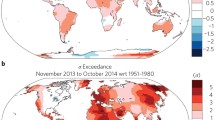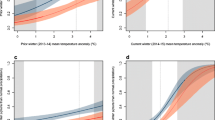Abstract
The purpose of this research was to explore the latent dimensions that underlie people’s use of adjectives that can describe weather and climate conditions. A sample of 1,011 university undergraduate students residing the southeastern United States evaluated the weather and climate of that region using 143 English language adjectives. Data were collected over a two-year period during various weather and seasonally related climatic conditions. Polychoric correlations among the adjective ratings were calculated; the matrix of correlations was factor analyzed. Twelve underlying factors related to weather and climate perceptions were observed: 1. threatening, severe, violent, 2. dismal, drab, dark, 3. cold and wintry, 4. hot and summery, 5. tranquil and pleasant, 6. stormy and wet, 7. bright and clear, 8. blowing and blustery, 9. damp and moist, 10. cloudy and cool, 11. predictable and unchanging, and 12. hazy and dusty. A second-order factor analysis revealed two factors pertaining to weather valence: 1. bad or extreme and 2. good or routine conditions. The study results were noteworthy in revealing some of the basic linguistic dimensions along which people perceive and experience weather and climate at the current time in the southeastern United States. The study also represents the use of a new technique for biometeorologists to use in assessing climate perceptions in culturally and climatically diverse regions.
Similar content being viewed by others
References
Auliciems A (1997) Comfort, clothing and health. In: Thompson RD, Perry A (eds) Applied climatology: principles and practice. Routledge, London
Brager GS, de Dear RJ (1998) Thermal adaptation in the built environment: a literature review. Ener Build 27:83–96
Bryson RA (1997) The paradigm of climatology: an essay. Bull Am Met Soc 78:449–455
Burroughs W (2003) Climate into the 21st century. University Press, Cambridge
Fischhoff B (1994) What forecasts (seem to) mean. Int J Forecast 10:387–403
Glanz M (2003) Climate affairs: a primer. Island Press, Washington
Harley TA (2001) The psychology of language: from data to theory, 2nd edn. Psychology Press, Hove, UK
Harley T (2003) Nice weather for the time of year: the British obsession with the weather. In: Strauss S, Orlove B (eds) Weather, climate, culture. Berg, Oxford, pp 103–118
John OP, Angleitner A, Ostendorf F (1988) The lexical approach to personality: a historical review of trait taxonomic research. Euro J Personal 2:171–203
Kasmar JV (1970) The development of a usable lexicon of environmental descriptors. Env Behav 2:153–169
Knez I, Thorsson S (2006) Influences of culture and environmental attitude on thermal, emotional and perceptual evaluations of a public square. Int J Biometeorol 40:258–268
Kyle WJ (1994) The human bioclimate of Hong Kong. In: Brazdil R, Kolár M (eds) Proceedings of the contemporary climatology conference. pp 345–350
Matzarakis A, Mayer H (1996) Another kind of environmental stress: thermal stress. WHO Newslett 18:7–10
Meyer WB (2000) Americans and their weather. Oxford University Press, Oxford
Nicholls N, Kestin T (1998) Communicating climate. Clim Change 40:417–420
O’Connor BP (2000) SPSS and SAS programs for determining the number of components using parallel analysis and Velicer’s MAP test. Beh Res Meth Inst & Comp 32:396–402
Panter AT, Swygert KA, Dahlstrom WG, Tanaka JS (1997) Factor analytic approaches to item-level data. J Pers Assess 68:561–589
Robinson PJ, Henderson-Sellers A (1999) Contemporary climatology, 2nd edn. Longman, Essex, UK
Stehr N, von Storch H (1995) The social construct of climate and climate change. Climate Res 5:99–105
Stern PC, Easterling WE (eds) (1999) Making climate forecasts matter. National Academy Press, Washington
Stewart AE (2007) A climate lexicon. Paper presented at the 87th Annual Meeting of the American Meteorological Society, San Antonio, Texas
Strauss S, Orlove BS (2003) Weather, climate, culture. Berg, Oxford
Toupin J (2001) Urban and rural perception of winter along the St. Lawrence valley: a case study on Trois Rivières and Champlain, Quebec. Proceedings from the 58th Eastern Snow Conference, Ottawa, Ontario, Canada
Unger J (1999) Comparisons of urban and rural bioclimatological conditions in the case of a Central-European city. Int J Biometeorol 43:139–144
Whyte AV (1985) Perception. In Kates RW, Ausubel JH, Berberian M (eds) Climate impact assessment: studies of the interaction of climate and society. John Wiley, Chichester, pp 403–436
Zwick WR, Velicer WF (1986) Comparison of five rules for determine the number of components to retain. Psych Bull 99:432–442
Author information
Authors and Affiliations
Corresponding author
Rights and permissions
About this article
Cite this article
Stewart, A.E. Linguistic dimensions of weather and climate perception. Int J Biometeorol 52, 57–67 (2007). https://doi.org/10.1007/s00484-007-0101-z
Received:
Revised:
Accepted:
Published:
Issue Date:
DOI: https://doi.org/10.1007/s00484-007-0101-z




